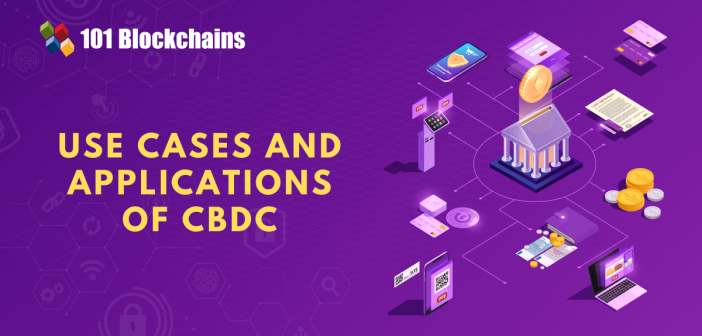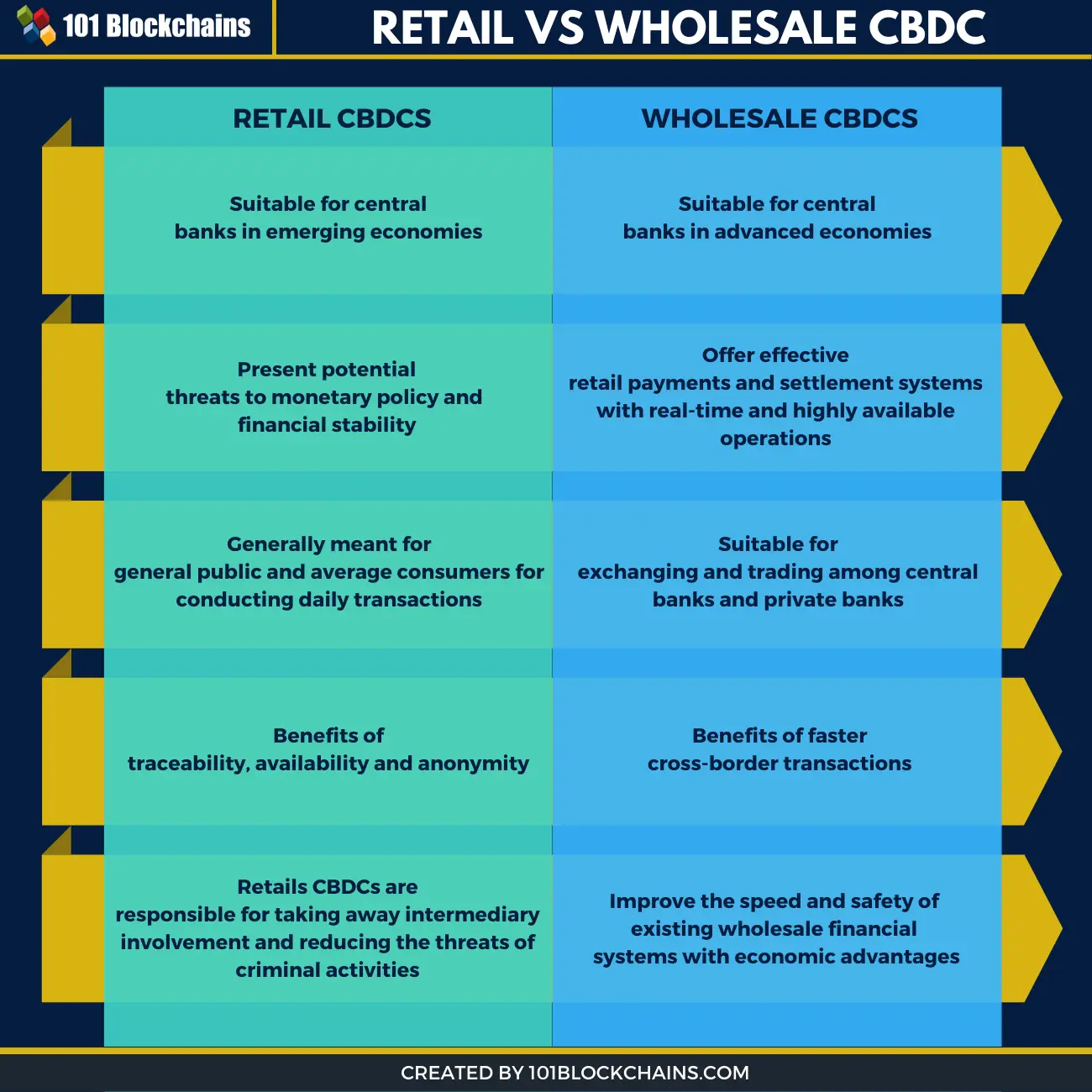Learn how blockchain truly works, master key definitions, and uncover what makes smart contracts so "smart." Dive into the fundamentals, gain valuable insights, and start your blockchain journey today!

- Cryptocurrency
Gwyneth Iredale
- on August 06, 2021
Central Bank Digital Currency (CBDC) – Use Cases and Applications
Aspiring to know about the CBDC use cases and applications? If yes, you have reached the right place.
Digital innovation has been a profound influence on different sectors, and the financial sector is no different. The focus on a larger global trend of fostering digitalization alongside a constantly expanding wave of innovation in the domain of consumer payments has resulted in promising improvements recently.
The arrival of central bank digital currencies (CBDCs) shows how the world is adopting technology to revise the conventional precedents of the financial services sector. As a result, the emphasis on central bank digital currency use cases has been growing profoundly in recent times. The following discussion helps you reflect on the crucial use cases of CBDCs and their applications with examples.
Want to know more about CBDC, Enroll Now in Central Bank Digital Currency (CBDC) Masterclass
Understanding CBDCs
The first thing that you need to know before learning about central bank digital currency applications is the definition of CBDC. Central bank digital currency is actually a digital form of central bank money if you want to put it simply. In technical terms, CBDC is a legal tender developed by a central bank with representation of a claim against the central bank.
The central bank bears complete liability for the CBDC rather than any commercial bank or payment service providers. It is also important to know that the management of CBDCs depends on a digital ledger, which is a blockchain platform such as Ethereum. The blockchain platform helps in speeding up payments between banks, individuals, and institutions with better security.
The interest in CBDC use cases is reasonably valid as over 70% of organizations in a recent study by the Bank for International Settlements affirmed that they were actively involved in research and development of proof of concept for CBDC projects. So, what makes CBDCs so unique in the present times? Here are the three important traits that signify the identity of central bank digital currencies.
- Central bank digital currencies or CBDCs are basically digital assets. The accounting of CBDCs happens in a digital ledger which serves as the single source of truth for all transactions with CBDCs.
- Central banks have to take complete responsibility for CBDCs. Just like banknotes, CBDC holders could have a claim against the central bank with CBDCs.
- Central banks are responsible for monitoring and managing the supply of CBDC. They are the sole authorities for controlling and determining the supply of CBDC according to pre-defined markers.
Build your identity as a certified blockchain expert with 101 Blockchains’ Blockchain Certifications designed to provide enhanced career prospects.
Types of CBDCs
With clarity on the essential traits of central bank digital currencies, it is obviously reasonable to focus on CBDC applications. Now, we know that CBDCs are just digital variants of currency generally issued by central banks. Another important aspect of CBDC implies that the monetary authority of the country is responsible for its regulation.
The design of CBDCs also includes a database which is crucial for the implementation of CBDCs. The database remains under the control of the government and central bank or any other authorized entities. Based on the design of CBDCs, you can find their two distinct variants such as,
- Account-based CBDC
- Digital tokens
Account-based CBDCs are one of the common types of CBDCs referred to as central bank electronic money. Account-based CBDCs are similar in functionalities to general deposit accounts. The user needs to set up an account that can help them carry out all transactions alongside sending and receiving digital currency. The CBDC use cases with account-based tokens would need access to the user information for verifying the IDs of the receiver and sender.
Digital token-based systems focus on transferring objects of value from one wallet to another. A token in the traditional financial systems would obviously refer to a coin or banknote. On the contrary, digital token-based systems do not have to depend on user identity verification for sending and receiving payments.
As a matter of fact, transactions with digital tokens are subjected to authentication with the use of public-private key pairs along with the digital signatures between the receiver and sender. However, central bank digital currency use cases with digital tokens have to face some common challenges. First of all, digital tokens do not have any identity requirements. The next and most critical threat in using digital tokens as CBDCs refers to the loss of access to assets with loss of tokens.
Watch on-demand virtual conference on Digital Assets and Central Bank Digital Currencies (CBDCs)
Use Cases of CBDCs
The answers to the question of “What is the use of CBDC?” definitely demand the attention of many enterprises which are exploring the potential of CBDCs. It is possible to tailor CBDCs for applications in retail as well as wholesale payments. Retail CBDCs could act as digital variants of cash you know and use on a regular basis. On the contrary, wholesale CBDC points out a novel infrastructure for settling transactions between banks. With prolific use cases in the financial sector, the understanding of CBDC applications depends considerably on the explanation of retail and wholesale CBDC.
-
Retail CBDC
One of the foremost use cases of CBDCs refers to retail CBDCs, which are utilized in payments between businesses and individuals or between individuals. They are similar in functionality to the digital variants of conventional currency notes. Interestingly, the volume of retail CBDC transactions easily exceeds 100,000,000 on a daily basis. However, the central bank digital currency applications in the retail CBDC model are generally associated with low value. At the same time, it is possible to carry out retail CBDC transactions with the help of various payment instruments.
Even if cash continues to be in use, a major share of retail payments has shifted base towards online transfers and cards. In the period from 2010 to 2018, electronic payments have depicted a sharp growth of almost 101% in the Eurozone. So, what can drive the use cases of retail CBDCs? The existing structure for electronic retail payment systems all over the world features three significant processes. The three processes are the transaction process, the clearing process, and the settlement process with prominent setbacks. An overview of the setbacks in existing processes of electronic retail payment systems could help in a better understanding of CBDC use cases.
- The transaction process is responsible for dispatching and delivering payment instructions to relevant parties from the sender as per the payment instrument. It also takes care of the verification and authentication of the sender and beneficiaries alongside the validation of payment instructions.
- The clearing process in digital retail payment systems focuses on matching payment data and processing it. Additionally, it also addresses the crucial task of determining settlement claims alongside obligations and ensuring the payment data reaches the settlement agent with utmost safety.
- The settlement process as the name implies ensures the effective transfer of funds between relevant parties after essential verifications. The verifications are generally associated with checking the availability of funds.
The scope for central bank digital currency use cases in retail payment systems arises from the complicacy emerging due to the involvement of different parties in electronic retail payment processes. For example, card payments feature acquirers, while cross-border transactions depend on currency exchanges.
The participation of so many parties could create prominent ambiguities regarding the applicable fees for transactions in retail payment systems. Such types of inefficiencies have been particularly evident in cross-border payments. For example, instant cross-border payments are far from reality, and the transaction costs with cross-border payments are exceptionally high.
Are crypto and CBDC different? Here’s a guide to help you understand the differences of Crypto vs CBDC.
Applications of Retail CBDCs
Retail CBDCs can find applications in two distinct variants, such as account-based CBDCs or digital tokens. With the help of deposit accounts in retail CBDC applications, individuals and businesses could open accounts with their central bank and receive benefits from similar services offered by commercial banks.
The accounts can help in initiating and receiving payments alongside viewing the account balance. On the other hand, digital tokens would be electronic replacements for coins and banknotes. Central banks could issue the tokens with commercial banks having the eligibility to distribute them.
A formidable difference between account-based and token-based retail CBDCs is the need for verification. CBDC accounts would need KYC procedures for verifying the accounts of CBDC holders. In the case of CBDC tokens, the process focuses on verifying the authenticity of tokens and transaction history.
-
Wholesale CBDC
The second prominent variant of CBDC use cases would bring wholesale CBDC into the equation. Wholesale CBDCs could help in ensuring payments alongside the settlement of transactions among financial institutions. Presently, banks could directly access electronic central bank money, and wholesale CBDCs may seem futile.
So, it is important to ask ‘What is the use of CBDC?’ especially in this case. Wholesale CBDCs help in improving efficiency and risk management in the settlement process. At the same time, they could also strengthen the benefits of efficiency and risk management by improving the accessibility of CBDCs.
Wholesale CBDCs can ensure that many financial market participants, who are presently unable to hold central bank accounts, can access CBDCs. At the same time, wholesale CBDCs are not applicable only in the case of pure money transfers but also for asset transfers that have securities involved. For example, two parties involved in trading of an asset like security in return for cash could use a wholesale CBDC for instant payment and delivery of the asset.
Check Out An Ultimate Guide on Central Bank Digital Currency On Corda!
Applications of Wholesale CBDCs
Central bank digital currency applications in the wholesale model could also be suitable for cross-border payments. Wholesale CBDCs could help in removing various intermediaries and reduce the complexity and cost of cross-border transactions. In addition, wholesale CBDCs could also add the value of automation for improving the efficiency of cross-border transactions.
A detailed comparison between Retail & Wholesale CBDC

Please include attribution to 101blockchains.com with this graphic. <a href='https://101blockchains.com/blockchain-infographics/'> <img src='https://101blockchains.com/wp-content/uploads/2021/01/central-bank-digital-currency.png' alt='central bank digital currency cbdc='0' /> </a>
Example of Use Cases for CBDCs
Central bank digital currencies are tailored for applications in the financial services sector. The basic design of CBDCs and the retail and wholesale models fit perfectly for different CBDC use cases. However, the real-world applications of CBDCs have a promising influence on developing a better impression of their use cases.
In a recent example, the National Bank of Ukraine has come up with interesting propositions regarding the introduction of a CBDC. The central bank carried out a survey with a questionnaire that focused on financial experts across different sectors. Almost 45% of the financial experts in the survey belonged to the retail sector, while 36% of them had prolific knowledge regarding financial experts.
The National Bank of Ukraine was finding out the possible factors for introducing a new CBDC-based system known as e-hryvnia. The e-hryvnia would facilitate cashless retail payments, and it emerged as the top preferred use case for CBDCs. Central bank digital currency use cases in the survey by The National Bank of Ukraine focused prominently on cross-border payments, cashless retail payments, even with programmable money, and the use of CBDCs for virtual asset transactions.
Interestingly, the primary motivation of Ukraine in introducing a CBDC does not emphasize a cashless society. On the contrary, the introduction of a CBDC solution would help in replacing other electronic money transactions. People of Ukraine believe that developing an e-hryvnia would ensure faster electronic transactions with better security.
CBDC – Long-Term Implications
As you can notice, the use cases of CBDCs are largely focused on offering three crucial functionalities. First of all, CBDCs and their applications aim to offer a reliable alternative to cash rather than serving as its replacement. The next important functionality of CBDCs evident in their use cases refers to the support for digitization.
With the help of digitization, CBDCs can offer exceptional benefits like peer-to-peer transfers, transparent and competitive ecosystems, along programmable payments featuring smart contract support. Furthermore, central bank digital currency use cases for cross-border payments could also utilize interoperability with foreign CBDCs or multi-CBDC platforms.
Start your blockchain journey Now with the Blockchains Fundamentals Course
Bottom Line
Based on the overview of use cases and the functionalities of CBDCs, it is reasonable to assume that CBDCs have promising potential. In the long run, they have the power to become the go-to option for financial transactions between people and businesses. At the same time, CBDCs would continue to revise the traditional precedents in the financial sector.
CBDC use cases can also play a credible role in changing the perceptions of people, governments, and institutions about digital money. CBDC has presented the possibilities for exceptional benefits with use cases in the retail and wholesale models. What matters now is the aim with which organizations look forward to developing a CBDC solution.
*Disclaimer: The article should not be taken as, and is not intended to provide any investment advice. Claims made in this article do not constitute investment advice and should not be taken as such. 101 Blockchains shall not be responsible for any loss sustained by any person who relies on this article. Do your own research!





